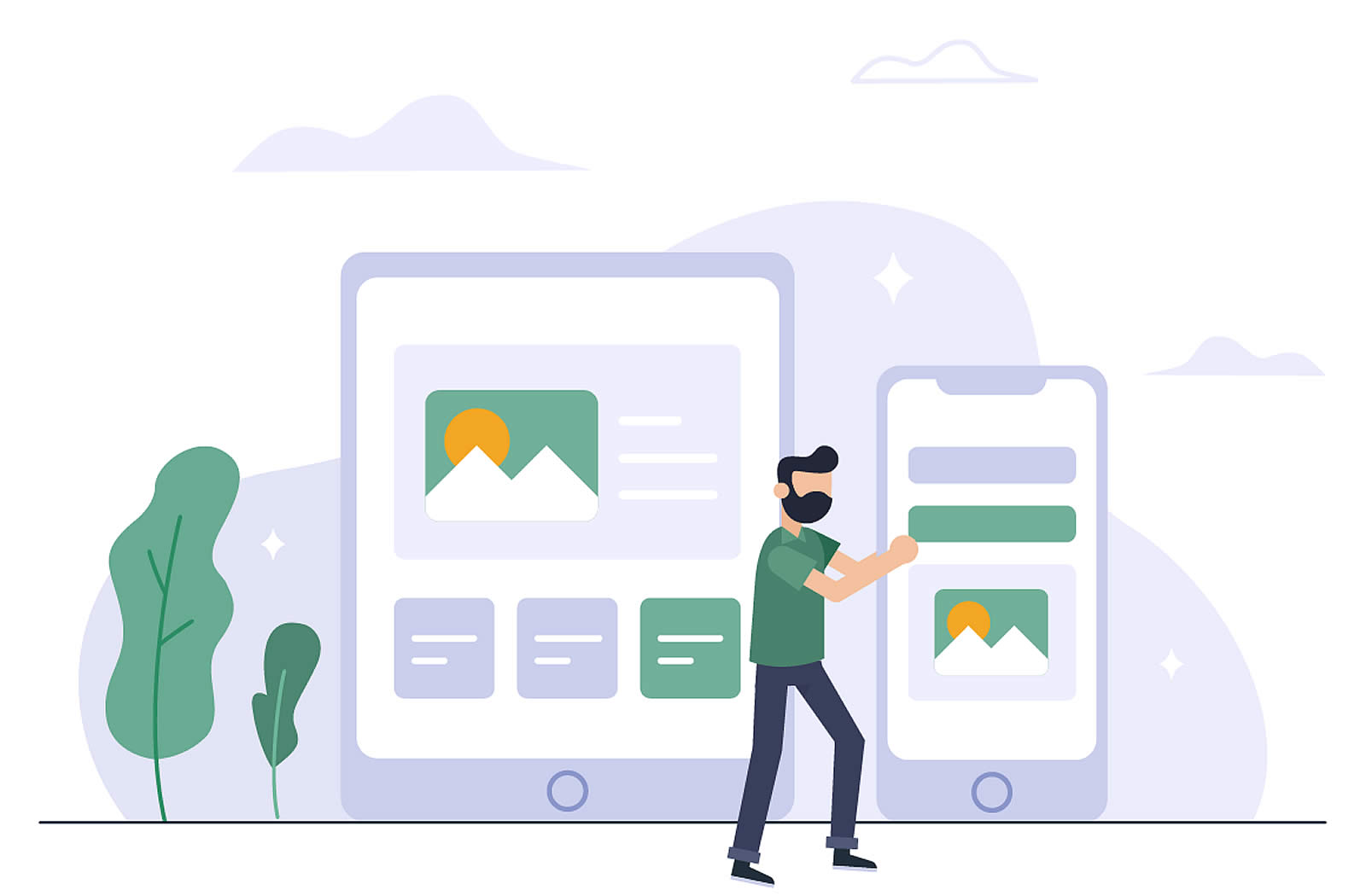
While mobile-friendliness is becoming more important, web designers must not forget the desktop as their primary source of traffic. 75% of internet users access the web via desktop devices. The proportion of mobile users is expected to decrease between 2020-2021. Although mobile devices have the largest screen size of all, it is still important to use desktop devices for most internet browsing. Here are some tips to help you understand how important it is to adjust web design for mobile devices.
Media queries
Media queries can be a great tool for designing websites that adapt to different screen sizes. Media queries can change the color of text and body depending on the viewport. To use media queries, open the source of the page in your browser. You can also use maximum and minimum values. In this article, we'll talk about how to create a responsive layout with media queries.
It is easy to adjust the layout by using media queries. The most common page sizes are 320px, 768px and 1200px. These sizes are suitable for tablets, smart phones, desktops and laptops. However, if your screen is larger than the above standards, you may need to change the appearance of your site. To do this, you should use CSS to adjust the layout of your site to fit different screen sizes.

Types of media
CSS media query is required to create responsive layouts. In HTML, media query were first introduced in CSS2.1. Media queries are tools that let users set distinct styles for print or screen sizes. Today, media queries can be used in CSS3 to display a different layout depending on the width of the user's device.
To choose the right size for your website, start by defining the minimum width of each screen. This width is normally around 360px. It can also be as wide as 500px. The readability theory, which suggests that a column's ideal length should not exceed 70 to 80 characters per line (or eight to ten English sentences), can be used to calculate the width. When the text block reaches that size, it is time to add a stoppoint.
Meta viewport
You can serve the same URL to a variety of devices using a meta viewport tag. This allows you maintain consistency across all devices. A responsive website can deliver the same URL to all users by detecting the browser's visible window size and delivering content accordingly. In addition to using a viewport element, you should also use the content attribute to set the width of the page to the width of the device. This will allow your page to automatically scale to the width of your device.
The viewport metatag tells the browser what page to display. It tells the browser how to adjust the size and scale of your page to fit the screen. The device-width metatag, which calculates the screen width in CSS pixels, is the best option. The zoom level that the browser displays the page at when it opens is controlled by the meta viewport tags. These values maintain a 1:1 relationship between device width and viewport. The browser automatically adjusts to suit the user's location when they orient the device.

Fluid image use
The first step in using fluid images for responsive web design is to understand how they work. Images are the largest element on a page, and this means that they must load first. Before loading external CSS or building the DOM, browsers first scan the page for image URLs. Images can be so large that the browser must first determine the size of the source images before it can decide how to crop them. This issue can be solved best by using a fluid image.
Consider the following when using fluid images in responsive websites: The image's dimensions will change depending upon the size of your viewport. It is ideal for small screens to cover the entire width of the viewport. Large screen images will only take up a fraction of that space. Images in fluid layouts must be able to stretch to match the size change, and be responsible for varying resolutions. Although fluid images can be made with many image formats, browsers are not often able to support WebP.
FAQ
What Should I Include in My Portfolio?
All these items should be part of your portfolio.
-
Examples of your previous work.
-
If you have one, links to it.
-
These are links to your blog.
-
Here are some links to social media pages.
-
These links will take you to the online portfolios of designers.
-
Any awards you received.
-
References.
-
You can also send us samples of your work.
-
These are links showing you how to communicate effectively with clients.
-
Here are some links to show that you're eager to learn new technologies.
-
These links show that you are flexible.
-
Links that show your personality
-
Videos showing your skills.
How much do web developers make?
The hourly rate for a website you create yourself is $60-$80. However, if you wish to charge more, you can become an independent contractor. The hourly rate could be anywhere from $150 to $200
How to design a site?
First, you need to know what your customers want from your site. What do they look for on your site?
What problem might they face if your site doesn't have what they are looking for?
You now need to know how to fix the problems. You also need to make sure that everything on your site looks right. It should be easy for users to navigate.
Your site should be extremely well designed. You should ensure that your site loads quickly. If it does take too long, people won't stay as long as they would like to. They will go elsewhere.
If you want to create an eCommerce site, think about where all of your products are located. Are they in one place? Are they scattered about your site?
You need to decide whether you want to sell one product at once or many different types of products. Do you want to sell just one type of product or multiple kinds?
After you've answered these questions, it is possible to start building your website.
Now, you have to think about the technical aspects of your site. How will your website work? It will it work fast enough? Can people get to it quickly from their computers?
Will people be able to buy something without having to pay extra? Do they need to register in order to buy anything?
These are the essential questions you should ask yourself. You'll be able to move forward once you have the answers to these important questions.
Statistics
- It's estimated that chatbots could reduce this by 30%. Gone are the days when chatbots were mere gimmicks – now, they're becoming ever more essential to customer-facing services. (websitebuilderexpert.com)
- Did you know videos can boost organic search traffic to your website by 157%? (wix.com)
- At this point, it's important to note that just because a web trend is current, it doesn't mean it's necessarily right for you.48% of people cite design as the most important factor of a website, (websitebuilderexpert.com)
- It enables you to sell your music directly on your website and keep 100% of the profits. (wix.com)
- In fact, according to Color Matters, a signature color can boost brand recognition by 80%. There's a lot of psychology behind people's perception of color, so it's important to understand how it's used with your industry. (websitebuilderexpert.com)
External Links
How To
What is website hosting?
Website hosting is the place where visitors go to visit a website. There are two types.
-
Shared hosting - This is the cheapest option. Your website files reside on a server owned by someone else. Customers who visit your website send their requests via the Internet over to that server. The request is then handed to the owner of that server.
-
Dedicated Hosting - This option is the most costly. Your website is located on only one server. There are no other websites sharing space on the server. Your traffic remains private.
Most businesses choose shared hosting because it's less expensive than dedicated hosting. The company hosting the server will provide the resources necessary to manage your website.
Both options have their pros and cons. Here are some key differences between them.
The pros of shared hosting:
-
Lower Cost
-
Easy to Setup
-
Frequent updates
-
It can be found at many web hosting providers
Hosting shared can be as low as $10 per month. Keep in mind, however, that bandwidth is usually included in the price. Bandwidth describes the amount of data that can be transferred over the Internet. So even if you only upload photos to your blog, you may still pay extra money for high amounts of data transferred through your account.
You'll soon realize why your old host cost so much once you get started. Many shared hosts offer very little customer support. Although their techs may help you with setting up your site, it's not a common practice.
Providers that offer 24-hour customer support are worth looking into. They'll take care of any issues that come up while you sleep.
Dedicated Hosting Cons:
-
More Expensive
-
Less common
-
Requires specific skills
With dedicated hosting, you get everything you need to run your website. You won't have worry about whether your website is using enough bandwidth, or whether it has enough RAM (random-access memory).
This means that you'll spend a bit more upfront. But once your online business starts, you'll realize you don't need any technical assistance. You'll be able to manage your servers effectively.
Which Is Better For My Business:
The answer to this question depends on which type of website you wish to create. If you only want to sell products, then shared hosting might be the best choice. It is simple to set up and easy to maintain. It's easy to set up and maintain, as you share a server with other sites. You will likely be updated frequently.
However, dedicated hosting can be a great option if you're looking to build a community around the brand. Instead of worrying about your traffic, you can build your brand while still being able to concentrate on your business.
Bluehost.com has both. They offer unlimited monthly data transfers and 24/7 support. You can also register domain names for free.